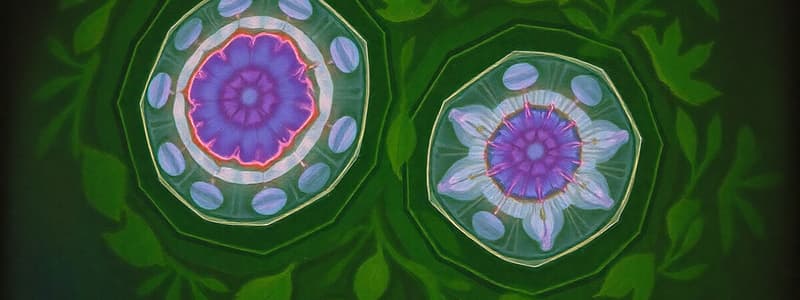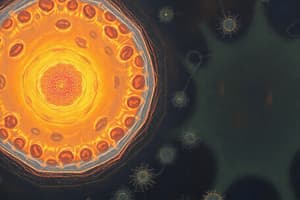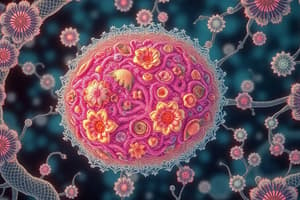Podcast
Questions and Answers
What role do glycolipids play in the cell membrane?
What role do glycolipids play in the cell membrane?
- They link fatty acids to carbohydrates. (correct)
- They are involved in cell communication.
- They serve as energy storage.
- They enhance membrane flexibility.
How does cholesterol affect the structure of the cell membrane?
How does cholesterol affect the structure of the cell membrane?
- It increases bond strength between fatty acids.
- It promotes fluidity within the lipid bilayer. (correct)
- It enhances the rigidity of the membrane.
- It limits the movement of membrane proteins.
Which type of membrane protein is primarily responsible for transportation across the membrane?
Which type of membrane protein is primarily responsible for transportation across the membrane?
- Extrinsic proteins
- Intrinsic proteins (correct)
- Adhesion proteins
- Signal receptors
What is one of the main functions of peripheral proteins?
What is one of the main functions of peripheral proteins?
What composes the liquid part of the cytoplasm?
What composes the liquid part of the cytoplasm?
What is the primary function of ribosomes in the cell?
What is the primary function of ribosomes in the cell?
Which compartment of the protoplasm contains the nuclear content?
Which compartment of the protoplasm contains the nuclear content?
Which of these is NOT a function of membrane proteins?
Which of these is NOT a function of membrane proteins?
What are microvilli primarily composed of?
What are microvilli primarily composed of?
Which of the following best describes the diameter of intermediate filaments?
Which of the following best describes the diameter of intermediate filaments?
What structural role do microtubules play in the cell?
What structural role do microtubules play in the cell?
How are centrioles arranged within the centrosome?
How are centrioles arranged within the centrosome?
What is the primary function of actin filaments in microvilli?
What is the primary function of actin filaments in microvilli?
What is the composition of each microtubule?
What is the composition of each microtubule?
Which structure is involved in the movement of cilia and flagella?
Which structure is involved in the movement of cilia and flagella?
What characteristic defines the mechanical properties of microtubules?
What characteristic defines the mechanical properties of microtubules?
What is the primary function of the lysosomes?
What is the primary function of the lysosomes?
Which component maintains the acidic pH required for lysosomal enzyme activity?
Which component maintains the acidic pH required for lysosomal enzyme activity?
How do vesicles containing enzymes become lysosomes?
How do vesicles containing enzymes become lysosomes?
What distinguishes a primary lysosome from a secondary lysosome?
What distinguishes a primary lysosome from a secondary lysosome?
Which of the following correctly describes the trans face of the Golgi apparatus?
Which of the following correctly describes the trans face of the Golgi apparatus?
What role do clathrin proteins play in the formation of lysosomes?
What role do clathrin proteins play in the formation of lysosomes?
Which statement is true regarding the composition of the Golgi apparatus?
Which statement is true regarding the composition of the Golgi apparatus?
Which type of lysosome is characterized by storing compounds resistant to complete digestion?
Which type of lysosome is characterized by storing compounds resistant to complete digestion?
What is the arrangement of the lipid molecules in the plasma membrane?
What is the arrangement of the lipid molecules in the plasma membrane?
Which component of the plasma membrane provides flexibility?
Which component of the plasma membrane provides flexibility?
What type of lipid molecules are found in lower proportions compared to phospholipids?
What type of lipid molecules are found in lower proportions compared to phospholipids?
Which part of a glycolipid is hydrophilic?
Which part of a glycolipid is hydrophilic?
What maintains the structural integrity of the plasma membrane?
What maintains the structural integrity of the plasma membrane?
Which of the following describes glycolipids?
Which of the following describes glycolipids?
Cholesterol is best described as which type of molecule within the membrane?
Cholesterol is best described as which type of molecule within the membrane?
What is the main function of the hydrophilic heads in the plasma membrane?
What is the main function of the hydrophilic heads in the plasma membrane?
The double layer structure of the plasma membrane allows for what characteristic?
The double layer structure of the plasma membrane allows for what characteristic?
Which part of the glycolipid is typically involved in cell recognition?
Which part of the glycolipid is typically involved in cell recognition?
What is the primary function of the cell membrane?
What is the primary function of the cell membrane?
Which of the following components constitutes about 30% of the proteins in the cell membrane?
Which of the following components constitutes about 30% of the proteins in the cell membrane?
Which type of lipid is the most abundant in the cell membrane?
Which type of lipid is the most abundant in the cell membrane?
What characteristic of the cell membrane allows it to maintain a potential difference?
What characteristic of the cell membrane allows it to maintain a potential difference?
What role do glycoproteins play in the cell membrane?
What role do glycoproteins play in the cell membrane?
Which statement about the cell membrane is incorrect?
Which statement about the cell membrane is incorrect?
Which of the following molecules makes up the polar head of phospholipids?
Which of the following molecules makes up the polar head of phospholipids?
What is the combined percentage of lipids and proteins in the cell membrane?
What is the combined percentage of lipids and proteins in the cell membrane?
Which component of the cell membrane helps to maintain its fluidity?
Which component of the cell membrane helps to maintain its fluidity?
What distinguishes intrinsic proteins from extrinsic proteins in the cell membrane?
What distinguishes intrinsic proteins from extrinsic proteins in the cell membrane?
What is the primary function of the Rough Endoplasmic Reticulum (RER)?
What is the primary function of the Rough Endoplasmic Reticulum (RER)?
Which of the following features distinguishes the Smooth Endoplasmic Reticulum (SER) from the RER?
Which of the following features distinguishes the Smooth Endoplasmic Reticulum (SER) from the RER?
What role do ribosomes play in protein synthesis?
What role do ribosomes play in protein synthesis?
What is the structural composition of the Golgi Apparatus?
What is the structural composition of the Golgi Apparatus?
What happens to proteins synthesized in the RER?
What happens to proteins synthesized in the RER?
Which cellular structure is primarily associated with the synthesis of proteins destined for the cell membrane?
Which cellular structure is primarily associated with the synthesis of proteins destined for the cell membrane?
Which face of the Golgi Apparatus is closest to the RER?
Which face of the Golgi Apparatus is closest to the RER?
What type of cellular components do polyribosomes primarily synthesize?
What type of cellular components do polyribosomes primarily synthesize?
Flashcards
Cell Membrane
Cell Membrane
The barrier that encloses the cell, separating the inside from the outside environment.
Phospholipid Bilayer
Phospholipid Bilayer
The cell membrane is made up of a double layer of lipids with embedded proteins. This arrangement creates a selective barrier that controls the passage of substances in and out of the cell.
Phospholipids
Phospholipids
Phospholipids are the most abundant lipids in the cell membrane. They consist of a hydrophilic head and a hydrophobic tail. The hydrophilic heads face the watery environment inside and outside the cell, while the hydrophobic tails are buried in the interior of the membrane.
Integral Proteins
Integral Proteins
Signup and view all the flashcards
Peripheral Proteins
Peripheral Proteins
Signup and view all the flashcards
Cholesterol
Cholesterol
Signup and view all the flashcards
Selective Permeability
Selective Permeability
Signup and view all the flashcards
Receptors
Receptors
Signup and view all the flashcards
Transport Proteins
Transport Proteins
Signup and view all the flashcards
Protein Synthesis
Protein Synthesis
Signup and view all the flashcards
Polyribosome (Polysome)
Polyribosome (Polysome)
Signup and view all the flashcards
Smooth Endoplasmic Reticulum (SER)
Smooth Endoplasmic Reticulum (SER)
Signup and view all the flashcards
Rough Endoplasmic Reticulum (RER)
Rough Endoplasmic Reticulum (RER)
Signup and view all the flashcards
Golgi Apparatus
Golgi Apparatus
Signup and view all the flashcards
Cis Face of Golgi
Cis Face of Golgi
Signup and view all the flashcards
Trans Face of Golgi
Trans Face of Golgi
Signup and view all the flashcards
Vesicles
Vesicles
Signup and view all the flashcards
What are Glycolipids?
What are Glycolipids?
Signup and view all the flashcards
What is Cholesterol's role in the cell membrane?
What is Cholesterol's role in the cell membrane?
Signup and view all the flashcards
What are extrinsic or peripheral proteins?
What are extrinsic or peripheral proteins?
Signup and view all the flashcards
What are intrinsic or integral proteins?
What are intrinsic or integral proteins?
Signup and view all the flashcards
What is one function of membrane proteins?
What is one function of membrane proteins?
Signup and view all the flashcards
What is another function of membrane proteins?
What is another function of membrane proteins?
Signup and view all the flashcards
What is another function of membrane proteins?
What is another function of membrane proteins?
Signup and view all the flashcards
What is another function of membrane proteins?
What is another function of membrane proteins?
Signup and view all the flashcards
Non-contractile bundles
Non-contractile bundles
Signup and view all the flashcards
Contractile bundles
Contractile bundles
Signup and view all the flashcards
Actin
Actin
Signup and view all the flashcards
Myosin II
Myosin II
Signup and view all the flashcards
Tropomyosin
Tropomyosin
Signup and view all the flashcards
Intermediate filaments
Intermediate filaments
Signup and view all the flashcards
Microtubules
Microtubules
Signup and view all the flashcards
Centrosome
Centrosome
Signup and view all the flashcards
Trans Face
Trans Face
Signup and view all the flashcards
Lysosomes
Lysosomes
Signup and view all the flashcards
Primary Lysosome
Primary Lysosome
Signup and view all the flashcards
Secondary Lysosome
Secondary Lysosome
Signup and view all the flashcards
Tertiary Lysosome (Residual Body)
Tertiary Lysosome (Residual Body)
Signup and view all the flashcards
Transport of Proteins from RER
Transport of Proteins from RER
Signup and view all the flashcards
Clathrin
Clathrin
Signup and view all the flashcards
Plasma Membrane
Plasma Membrane
Signup and view all the flashcards
Glycolipid
Glycolipid
Signup and view all the flashcards
Membrane Fluidity
Membrane Fluidity
Signup and view all the flashcards
Membrane Transport
Membrane Transport
Signup and view all the flashcards
Membrane Integrity
Membrane Integrity
Signup and view all the flashcards
Lipid Bilayer
Lipid Bilayer
Signup and view all the flashcards
Study Notes
Cell Biology
- Cells are the fundamental functional and structural units of living organisms
- Unicellular organisms consist of a single cell
- Multicellular organisms have several cells grouped together, specialized in specific functions
- Cells are organized into tissues, organs, and organ systems
Levels of Organization
- Cells combine to form tissues
- Tissues combine to form organs
- Organs combine to form organ systems
Prokaryotic and Eukaryotic Cells
- Prokaryotic cells (e.g., bacteria) lack a nucleus and other membrane-bound organelles
- Eukaryotic cells (e.g., animal cells) have a nucleus and membrane-bound organelles
Animal Eukaryotic Cell
- Surrounded by a plasma membrane
- Contain cytoplasm, organelles (for specific functions), and a nucleus (genetic material)
- The number and arrangement of organelles vary among cell types
Cell Membrane (Plasma Membrane)
- A selectively permeable barrier between the cell's interior and the external environment
- Maintains cell integrity
- Regulates molecular exchange
- Involved in cell-cell interactions
- Receives and transmits signals
- Composed primarily of lipids and proteins
Cell Membrane Components
- Lipids (40-50%): Phospholipids, glycolipids, cholesterol
- Proteins (60-50%):
- Intrinsic proteins: integral (transmembrane) or partially integrated
- Extrinsic proteins: peripheral
Phospholipids
- The most abundant membrane lipids
- Have a hydrophilic head and hydrophobic tails
- Form a bilayer structure
Glycolipids and Cholesterol
- Less abundant than phospholipids
- Each plays a role in maintaining membrane structure and function
Membrane Proteins
- Extrinsic/Peripheral proteins are associated with the membrane's surface
- Intrinsic/Integral proteins are embedded within the membrane (transmembrane or partially integrated)
- Functions: transport, adhesion, and signal reception
Functions of Membrane Proteins
- Transport - moving molecules across the membrane
- Adhesion - establishing cell junctions
- Signal Reception - receiving external signals and transmitting them to the interior of the cell
- Enzymes - catalyzing reactions at the membrane's surface
Protoplasm
- The living substance of the cell
- Divided into two compartments:
- Cytoplasm - extends from the plasma membrane to the nuclear envelope
- Cytosol - the liquid part of the cytoplasm
- Carioplasm - forms the content of the nucleus
Cell Organelles
- Specialized structures within a cell that perform specific function
Ribosomes
- Small organelles composed of ribosomal RNA (rRNA)
- Responsible for protein synthesis
- Messenger RNA (mRNA) carries the genetic code
- Transfer RNA (tRNA) brings amino acids to the ribosome, based on the mRNA code.
Ribosomes associated with membranes
- Synthesize proteins destined for membranes or secretion from the cell
Endomembrane System
- Involved in synthesis, processing, and transport of proteins and lipids
- Includes endoplasmic reticulum (RER and SER), Golgi apparatus, and nuclear envelope
Endoplasmic Reticulum (ER)
- Extensive network of membranes
- Rough ER (RER), is studded with ribosomes and involved in protein synthesis and folding
- Smooth ER (SER), lacks ribosomes and involved in lipid synthesis, steroid hormone production and detoxifying processes
Golgi Apparatus
- Stacked flattened sacs (cisternae)
- Modifies proteins and lipids produced in the ER
- Sorts and packages these molecules into vesicles for transport to their final destinations
Lysosomes
- Membrane-bound organelle containing hydrolytic enzymes
- Degrades macromolecules, microorganisms, and damaged organelles
- Maintains an acidic internal environment to protect other cellular components
Peroxisomes
- Spherical or oval-shaped organelles
- Contain enzymes for detoxifying reactions, including reactions producing hydrogen peroxide
- Important in metabolism of harmful substances
Mitochondria
- Powerhouse of the cell
- Site of cellular respiration (using oxygen to produce ATP)
Inner Mitochondrial Membrane
- Contains cristae, extensively folded to increase surface area for ATP synthesis
- Contains protein complexes that form the Electron Transport chain
Mitochondrial Matrix
- Contains enzymes for Krebs cycle, produces ATP
Nucleus
- Largest organelle, contains genetic material (DNA)
- Involved in gene expression and cell division
- Contains the nucleolus, responsible for ribosome synthesis
Nuclear Envelope
- Double-layered membrane surrounding the nucleus
- Contains nuclear pores that regulate transport between the nucleus and cytoplasm
Chromatin
- Complex of DNA and proteins (histones)
- Condenses to form chromosomes during cell division
Chromosome
- Structure containing DNA and proteins
- Important in cellular division
Cytoskeleton
- Network of protein filaments within the cytoplasm
- Gives the cytoplasm shape and support
- Involved in movement and intracellular transport.
- Consists of:
- Microfilaments (movement - muscle contraction)
- Intermediate filaments (structural support)
- Microtubules (structural support, intracellular transport - mitosis)
Centrioles
- Cylindrical structures (composed of microtubules)
- Important for organizing microtubules during cell division.
- Part of the centrosome
Cilia & Flagella
- Extensions of the cell membrane
- Structure: microtubule-based axonemes
- Involved in movement of substances or the entire cell
Studying That Suits You
Use AI to generate personalized quizzes and flashcards to suit your learning preferences.
Related Documents
Description
Explore the fascinating world of cell biology, including the fundamental units of life, levels of organization, and differences between prokaryotic and eukaryotic cells. This quiz will help you understand how cells combine to form tissues, organs, and organ systems, as well as the unique features of animal eukaryotic cells. Test your knowledge on the structure and functions of cells in living organisms.



